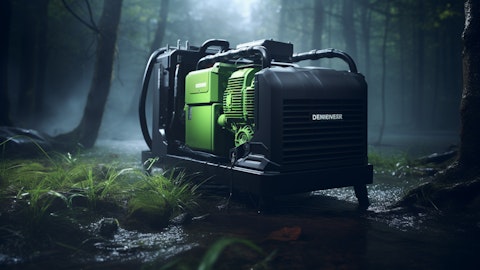So this is a real priority for this type of operators who are looking at the future to really look at decarbonization, hydrogen is going to play a big, big role there. I don’t think you’re going to see high volume in the next year or two. This is going to take a number of years to validate, but we are very well-positioned with the solutions we have, with the partnerships that we have to play an important role in this market. On the commuter rail market, we have a number of partners there. Siemens that we’ve announced for the European commuter rail market. They, obviously, have an increasing presence in the North American commuter rail market too. And then Stadler is another customer for the North American and European market as well. So we see, I would say, growth in this market by 2030.
I think we’re going to see very clear validation both to the commuter rail and for the locomotive market that puts it on a very strong pathway moving forward. For the truck market, this market is actually moving slower than I would like, and there are a variety of reasons for that. We have been focused on what I’ll call the truck market opportunities we have returned to base refueling. So think about things like drayage trucks and regional haul trucks that are coming back to the same base or yard at night. So you can avoid that distributed refilling infrastructure. And we see a number of applications in different weight ranges that will have, I think, hydrogen fuel cells as the primary solution. There will be some battery electric in some of these weight ranges as well.
I think it’s going to be a mixed solution. But it is taking longer, and I think the vehicle OEMs who’ve been investing quite a bit in different technologies, including autonomy, including battery electric are now looking at the hydrogen fuel cell investments as well. So we see a number of opportunities that are in the, I would say, early stages of validation with these customers as they’re going through their RFP and RFQ processes and we’re very active on this front. So we are seeing, I’d say, increased activity from truck OEMs, the large credible ones who are looking to bring solutions to market on the 2028 to 2030 time frame. In parallel to that, we’re working with a number of what I would call the upfitters. So entrepreneurial companies that see a market gap today and are rushing to market with, in many cases, both battery electric and fuel cell electric depending on the use case and are looking to Ballard to provide them with fuel cell engines.
And so that upfitter market is a market that we’re also working on. So we have two flows of traffic, if you will, two streams of opportunity in the truck market. We’re advancing both of them, but it is taking longer than we’d like.
Saumya Jain: Got it. Thank you so much.
Operator: The next question comes from Mac Whale with Cormark Securities. Please go ahead.
Mac Whale: Hi, good morning. As you noted, Randy, strong six months for new orders, I’m wondering, what are your thoughts on the variability of that going forward? I mean, you’ve seen in the past when you get these big orders and it draw some activity level from the next quarters? Do you think you’re through that now with these big long-term sales agreements? Or do you think we’re going to see some — where we should be expecting maybe a little bit more soft on the new order side, your thoughts there?
Randy MacEwen: Yeah. Great question, Mac. What I would say is this is still very much early-stage demonstration market where some customers are earlier in their processes. But I do see that while there will be lumpiness and some of the market opportunities we are pursuing, like, for example, the back-up power market for data centers or the marine market or even the rail market, you’re looking at much larger size applications, power applications. And if you get scale orders there, it’s quite different than the type of orders you’d see from the bus market. So I think we’re going to see — continue to see a lot of variability and a lot of lumpiness. It will be based in some part on seasonality and some part, based on when funding sources are available.
And of course, a couple of the contracts we’ve signed are long-term supply agreements with fixed volumes associated with them. So that doesn’t happen every quarter. So there will be some variability. But I would see the trend is towards larger order books and the trend is towards getting a smoother cadence of growth going forward. We do see a very strong sales pipeline, expect to see some additional large orders through the year. So our job is to close those out.
Mac Whale: Okay. I guess related to that, I guess as more evidence to support that is — if you look at the 12-month backlog, it’s actually, kind of back to where it was in 2021 when you had — correct me, if I’m wrong, a lot more technology-related sales in the 12-month order book, is that correct?
Randy MacEwen: Yes. I mean I think that’s one thing that’s probably been misunderstood in some ways. People kind of look at the revenue as being flat and in some cases, the order book is being flat, which has been true for a number of years, but the composition has changed dramatically, and so we’re going to a situation now where we’re reaching almost 90% revenue and similar on the order book front and certainly, on the sales pipeline, it’s heavily, heavily dominated by the sale of fuel cell engines now. So just as an illustrative example, last year, we shipped over 500 fuel cell engines, a record year for Ballard on that front. You know, in the first quarter, we shipped over 100, which is a record for Q1.
Mac Whale: Okay. And just as a second question, just switching gears on the — you kind of addressed this a little bit on the giga factory in the US and that’s up and running. I know it’s still a few years out. What is the contribution margin look like? In the past, you’ve spoken about contribution margin as opposed to sort of the margins you’re reporting. Is there any change in what you expect to see when that’s up and running? Not sure you want to frame that? Yes.
Randy MacEwen: Yes. Yes. So we will see a significant reduction in our costs as we move forward on manufacturing. And so when you look at the processes for MEA, the processor for bipolar plate production, the other areas we’re seeing significant cost reduction opportunity with automation and different processes that really help with things like yield and scrap rates, et cetera, that all go back to cost. So we will see a very significant difference in material costs, direct material and direct labor costs as we scale in a high automated facility. And then as from — as you move from contribution margin to gross margin, then it becomes a function of getting the volume and getting your fixed overhead absorption across a bigger book of business. So — we’re actually very excited about the opportunity for both contribution margin expansion and gross margin expansion, particularly as volume hits in that new facility.
Mac Whale: Okay. Great. Thanks. That’s all my question. Thank you.
Randy MacEwen: Thanks, Mac.
Operator: The next question comes from Rupert Merer with National Bank. Please go ahead.
Rupert Merer: Hi, good morning. Thanks for taking the question. I wanted to follow-up on the cost reduction and pricing strategy. With the orders you’ve announced recently, are the prices you’ve offered for larger volumes out to 2027, representative of prices that are sustainable in the long run or to put that another way, are your prices getting to a level that could be competitive with diesel buses on a TCO basis.
Randy MacEwen: Yes. I think what we’ll see is that as we move forward, we’re going to see — and this happened very similarly in the solar industry and wind and happen in the battery electric market. There are some variability in those markets, particularly when depending on supply and demand balances, but also very high dependency in some thesis on rare earth metals and certain commodities. I don’t see that going forward here on the commodity front in terms of variability. But what I would say is we’re going to expect to see selling price reduction on an annual basis. And our job is to make sure that our cost reduction exceed selling price erosion so that we’re effectively seeing margin expansion. And so that’s what we currently have in our plan is we’re assuming a certain percentage, it varies by year, but there is a kind of an overall blended percentage of cost reduction that customers are expecting.
And certainly, in the larger long-term supply agreements that we’ve been signing up recently, we have cost reduction and selling price — we have selling price assumptions reductions in there and is supported by cost reduction assumptions that we have in our plan.




